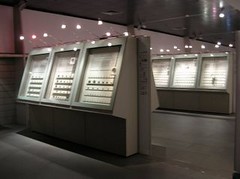
PREV ARTICLE
NEXT ARTICLE
FULL ISSUE
PREV FULL ISSUE
V11 2008 INDEX
E-SYLUM ARCHIVE
THE COIN COLLECTION AT THE MUSEO NAZIONALE ROMANO
Last week on his Numismatics and Archaeology blog,
Nathan Elkins published a piece on his recent visit to Rome and the coin
collection at the Museo Nazionale Romano - Palazzo Massimo alle Terme.
Here are some excerpts.
Nathan is a Ph.D. Candidate in Greek and Roman Art and Archaeology at the University of Missouri, writing a dissertation on Architectural Coin Types: Reflections of Roman Society. -Editor
Nathan is a Ph.D. Candidate in Greek and Roman Art and Archaeology at the University of Missouri, writing a dissertation on Architectural Coin Types: Reflections of Roman Society. -Editor
 One place I have consistently visited every
time I go to Rome is the Museo Nazionale Romano - Palazzo Massimo alle
Terme. The museum is located next to Termini train station and contains a
very import collection of sculpture, wall paintings and, of course, coins.
Naturally, this museum was on our itinerary, since I wanted to ogle the
magnificent numismatic collection once again. My mother was not as
impressed with the coins as she was with the wall paintings, sculptures,
and fine mosaics, but I was able to make a quick jaunt through the
basement vault where the coins are kept anyway.
One place I have consistently visited every
time I go to Rome is the Museo Nazionale Romano - Palazzo Massimo alle
Terme. The museum is located next to Termini train station and contains a
very import collection of sculpture, wall paintings and, of course, coins.
Naturally, this museum was on our itinerary, since I wanted to ogle the
magnificent numismatic collection once again. My mother was not as
impressed with the coins as she was with the wall paintings, sculptures,
and fine mosaics, but I was able to make a quick jaunt through the
basement vault where the coins are kept anyway.Unlike most of the important western collections of ancient coins, those in Rome often contain significant proportions of coins that are known to have been recovered in Rome and Italy. Most of the coins in the cases at the Palazzo Massimo come from the private collection of Francesco Gnecchi, a numismatic scholar from the late 19th and early 20th century, but other displays include excavated hoards and finds as does its larger inventory which cannot be displayed at once. Some 60,000 - 70,000 ancient coins from the Rome, which were recovered during the risorgimento, await publication by the numismatists at Frankfurt. Some finds from the Tiber River have already been published.
 The extensive display at the Palazzo Massimo
allows visitors to view the evolution and development of the Roman
monetary system in a chronological fashion and also includes later
medieval and modern coins from Italy.
The extensive display at the Palazzo Massimo
allows visitors to view the evolution and development of the Roman
monetary system in a chronological fashion and also includes later
medieval and modern coins from Italy. Unlike most museums containing ancient coin displays, the cases at Palazzo Massimo have magnifiers that visitors can manipulate electronically to view select coins in greater detail. Often, however, I have found some of these inoperable. Nevertheless, any numismatist or ancient coin enthusiast who passes through Rome ought to visit this collection and the other important holdings of this fantastic museum. In some ways it's a much more enjoyable experience than visiting the Capitoline Museums or the Vatican Museums, where one has to fight the throngs of tourists.
To read the complete article, see: The Coin Collection at the Museo Nazionale Romano - Palazzo Massimo alle Terme (http://coinarchaeology.blogspot.com/2008/09/coin-collection-at-museo-nazionale.html)
Wayne Homren, Editor
The Numismatic Bibliomania Society is a non-profit organization promoting numismatic literature. See our web site at coinbooks.org.
To submit items for publication in The E-Sylum, write to the Editor at this address: whomren@gmail.com
To subscribe go to: https://my.binhost.com/lists/listinfo/esylum
All Rights Reserved.
NBS Home Page
Contact the NBS webmaster
